Background
Military Chaplains
Chaplains are clerics that represent a religion in a secular institution, such as schools and hospitals. Specifically, military chaplains aid soliders in the military by providing spiritial support and morale. Regardless of the religion they practice, chaplains often work with military personnel of various faiths.
Data supplied from Military Factor3
Army Regulations Document on Chaplains
Role in World War II
During WWII, chaplains were sent to serve alongside soldiers in the war by providing moral support and guidance. Most chaplains were non-combatants; however, some British chaplains were armed. Duties of chaplains were similar to clergymen in civilian life -- they conducted religious services, witnessed events such as weddings and funerals, and guided lectures about diseases and death.
Chaplain in Training Camps
Before chaplains were sent into combat, many chaplains trained alongside soldiers in the training camps and spoke about national and spiritual unity. Additionaly, chaplains conducted church services, provided moral support and guidance, and developed a relationship with many soldiers.
"A comforting word, a prayer uttered in their ears, a blessing bestowed upon them, and they beam, fairly beam with the light of the grace of God."
- Father Francis A. Kelly, American Catholics in the War 2
Upon endorsement from religious institutions and completion of seminary training, chaplains were sent to serve alongside soldiers across the United States in training camps. Prior to WWII, chapels were not commonplace in training camps. In 1941, Congress granted the Army with over 13 million dollars in order to build 604 chapels in training camps across the United States.4 In the Navy training facilities, chaplains oftentimes had to use commonspaces as a makeshift worship space.
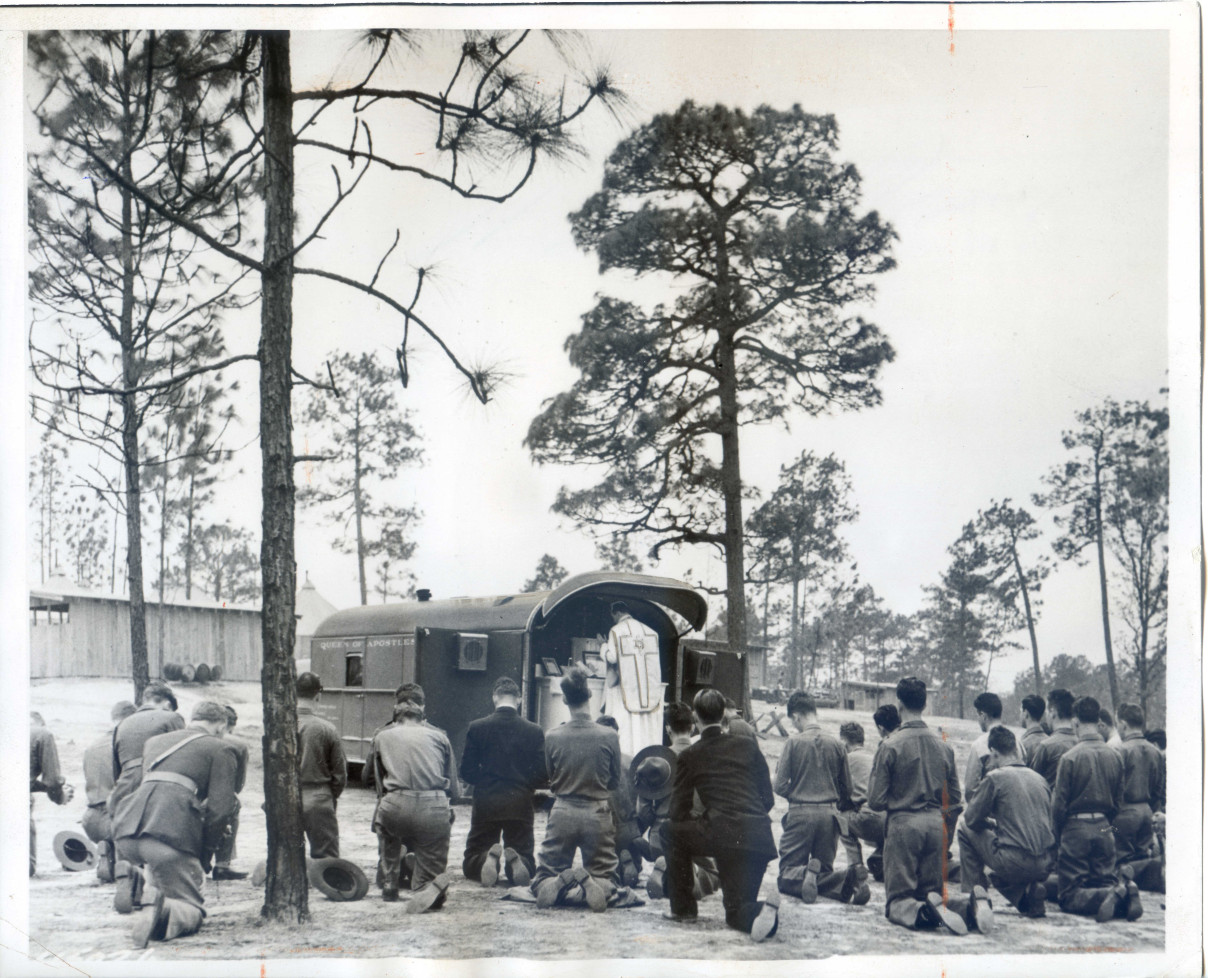
“Army’s Trailer Church. Washington D.C. — Catholic Soldiers shown during Mass celebrated by a chaplain in a trailer church equipped with public address system, altar, pulpit and hymn books. The War Department will provide each division with ton-and-a-half trailer churches similar to this one.” U.S. Army Signal Corps photo, 25 Nov 40.
Army regulations 60-5, outlines the specific duties, chain of command, and expectations of the WWII chaplain. At the training camps, chaplains were to “organize worship services, recruit volunteers to serve as vocalists in a choir and recruit readers for scripture lessons.”5 Among the most beneficial of the chaplain’s duties seemed to be moral and spiritual counseling. In the training camps specifically, chaplain’s made themselves highly accessible to soldiers. According to the WWII US Medical Research Centre, chaplains “were present everywhere, at training sites, rifle ranges, mess halls, road marches, gas mask drills, jump towers, ship drills, boot camp, medical training, etc.”1 According to “Army Regulations 60-5,
“chaplains were to serve as friends, counselors, and guides without discrimination, to all members of the command to which they are assigned, regardless of creed or sect, and will strive to promote morality, religion, and good order therein.”6
By building relationships with their soldiers, chaplains contributed to morale in the training camps and provided an escape from the rigorous physical and mental stimulation of training for war.
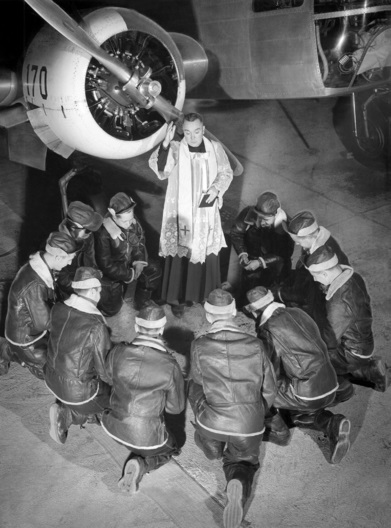
“Continuous night bombing schedule of the intensive bombardier training program allows no time out for Christmas Eve worship. Lt. Eugene F. McCahey, flying chaplain of San Angelo Army Air Field, bring the Christmas message to the bomber flight line on Dec. 24, 1942. Pausing after the cadets receive his blessing before continuing their practice blasting of the 18,000 acres of this bombardier school’s night target bombing ranges in San Angelo, Texas. Chaplain McCahey is himself a pilot.”
Although religious service attendance could not be commanded by Officers, many commanding officers would “highly suggest” their soldiers attend worship.7 The rigor of the training camp often times broke down the individual soldier’s sense of self, took away some of their freedom of choice, and suggested the soldier conform in order to serve the greater good. Religion, therefore, was the one aspect soldiers could choose. In the training camps, religion provided individualism for soldiers. By celebrating religious holidays, attending worship services, and building a relationship with chaplains, the soldiers relied on the chaplaincy in understanding their role in the war.
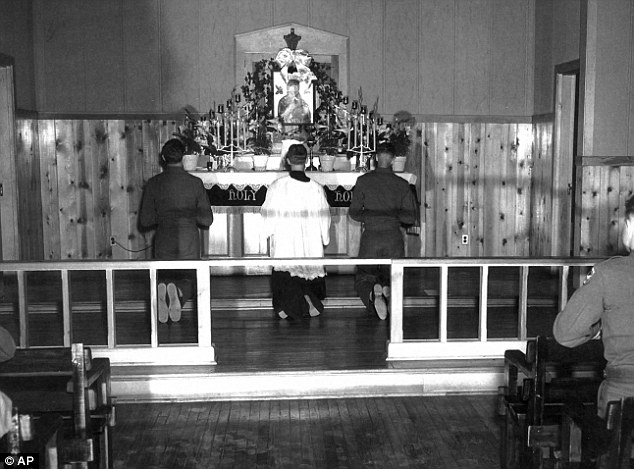
Chaplain (CPT) Emil Kapaun (center) celebrates Mass at Herrington Army Air Base, 1942.
The most significant challenge of the chaplain’s in training camps was how to serve soldiers from differing religious backgrounds. Although the chaplain adhered to one particular faith, he had to serve soldiers from differing religious backgrounds at the training camps. This was a difficult task, as differing religions celebrate various holidays throughout the year and adhere to diverse traditions. All in all, many soldiers viewed religious holidays and ceremonies as a way to come together and understand one another better. As their time in the training camp came to a close, many soldiers depended on the spiritual and moral guidance of their chaplains in order to better prepare for their time overseas.
Chaplains Overseas
The Chaplain’s role in WWII did not end when soldiers left the training camps. Overseas, chaplains maintained many of their same duties as in training camps, such as conducting religious services and providing moral counseling. Often times, chaplains inserted themselves into the heart of the war by attending to soldiers needs on the battlefield. Countless stories about WWII military chaplains highlight the valor of their service overseas.
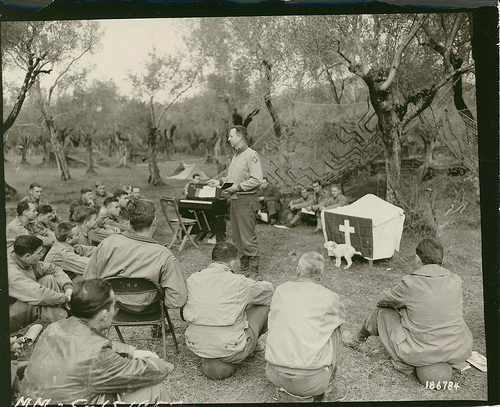
“Christmas Day services near the front, in Italy. Lt. Col. William E. King, of Kansas City, Mo., Chaplain of the 45th Division, speaks to men assembled near their Bivouac Area. Notice the Young dog by the Altar.” Venafro area, Italy. 25 December 1943.
Methodist minister the Reverend George L. Fox, Reform Rabbi Alexander D. Goode(Ph.D.), Roman Catholic priest Father John P. Washington, and Reformed Church in America minister the Reverend Clark V. Poling are four heroic men who served during WWII. The Four Chaplains story begins and ends February 3rd, 1943. Heroically, these four men worked to calm army soldiers aboard a ship under fire. The chaplains tended to the wounded, distributed lifejackets when it was apparent the ship was going under, and ultimately gave their lives in order to serve the greater purpose of the American Army.
Chaplain Robert Preston Taylor served the 31st Infantry division, Philippine Division.8 Soon after arriving to the Philippines, the US Army surrendered their forces. Upon surrender, Taylor become a prisoner of war and part of the “Death March” to the camp.9 At the camp, Taylor continued to serve hospital patients, eventually being sentenced to solitary confinement for smuggling food and medicine to the patients.10 Taylor later became the Chief of Chaplains for the US Air Force.11
Chaplain, Lieutenant Father Joe Lacy served on the front lines during D-Day. During the battle, Lacy pulled men out of the water and onto the shores of the beach.12 He treated the wounded soldiers and prayed with dying soldiers on the beach of Normandy.
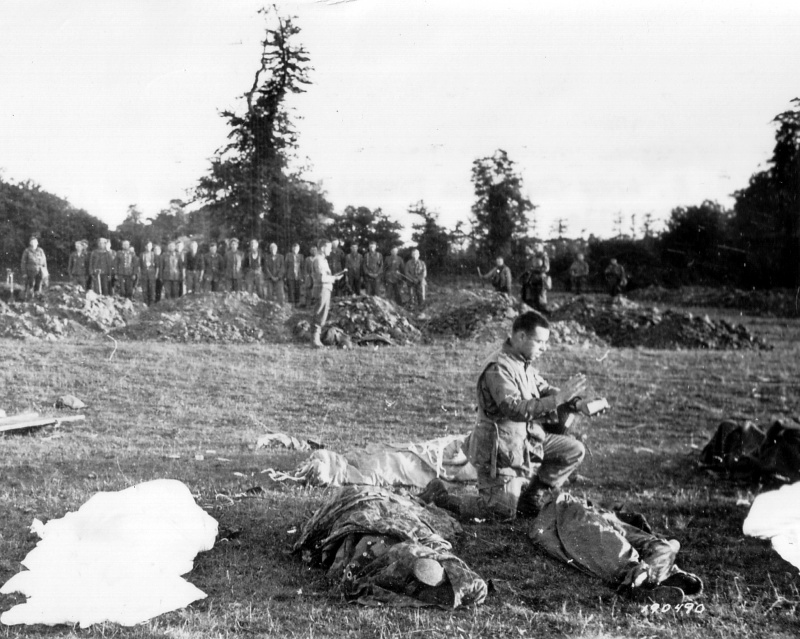
Chaplain F. Sampson blessing dead soldiers of the 501st American Parachute Regiment in Normandy.
These three stories highlight the heroic efforts of military chaplains during WWII overseas. All throughout the world during WWII, U.S. chaplains served their country, men, and God. Overseas, chaplains held religious services before battle in order to lift the spirits and mindsets of their soldiers.13 During battle, chaplains oftentimes risked their own lives to comfort injured and dying men in battle.14 Chaplains during WWII set aside religious differences and worked to serve one greater good, the US Military. The selflessness of many the military chaplains who served overseas during WWII, comforted and saved many of the men fighting for our country.
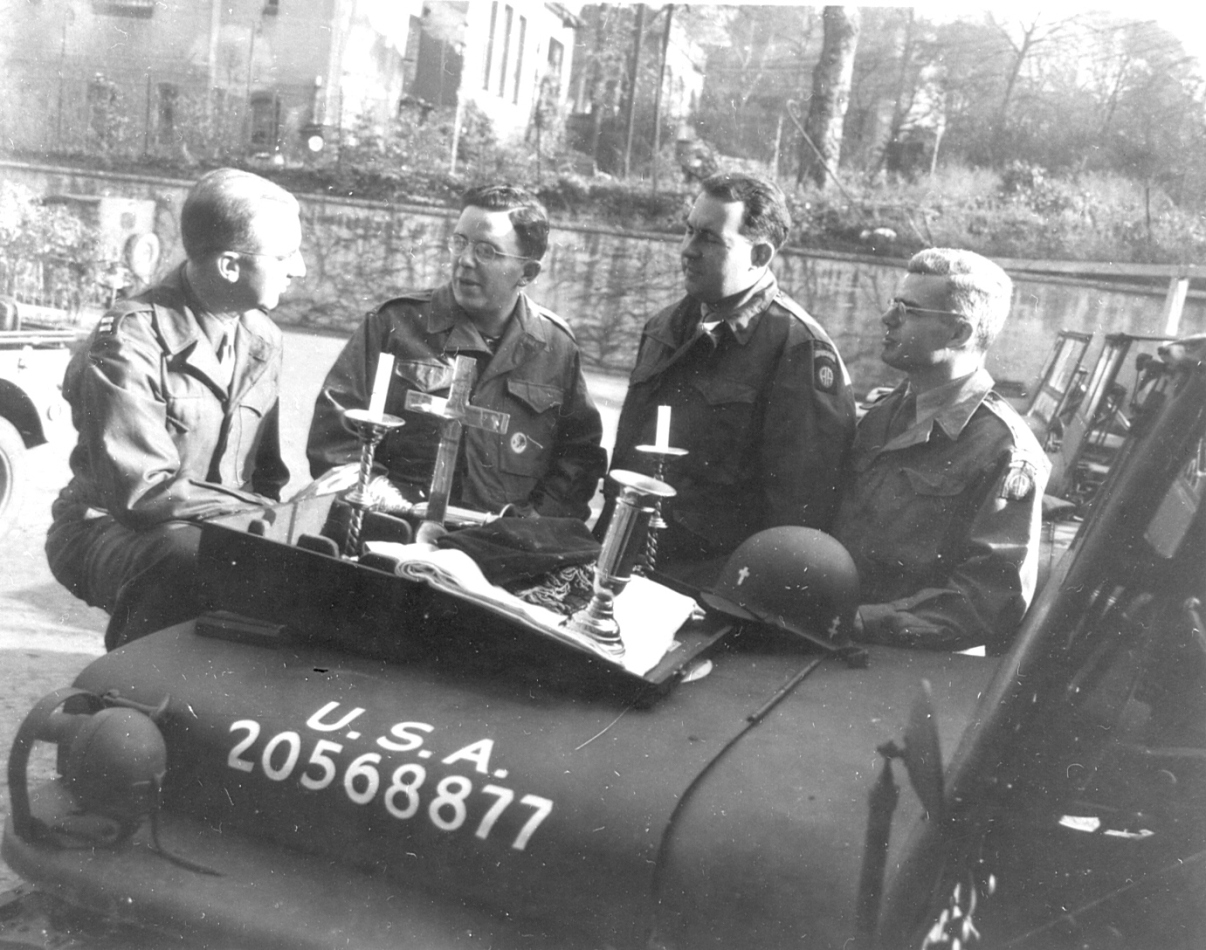
Unidentified chaplain visiting with Soldiers of the 82nd Airborne Division in WW2.
Religions Represented
It was during WWII that the United States truly began to expect tolerance of Catholicism, Protestantism, and Judaism.
Data supplied from the WW2 US Medical Research Centre1
Sources
[1] “The Chaplain Corps,” WW2 US Medical Research Centre, accessed 12 April 2018, https://www.med-dept.com/articles/the-chaplain-corps/
[2] Way, John. The Soldier Priest. Dominica. Volume XXVIII. No. 2. 1943
[3] "Military Ranks." www.militaryfactory.com/ranks/index/.
[4] Piehler, Kurt, A Religious History of the American GI in World War II, to be published, chapter 3, page 5
[5] Dorsett, Lyle W., Serving God and Country: U.S. Military Chaplains in World War II, (New York: Penguin Group, 2012), 42
[6] U.S. Department of the Army, Chaplains: General Provisions, Regulation 60-5, Washington, D.C., 1941
[7] Piehler, Kurt, A Religious History of the American GI in World War II, to be published, chapter 4, page 7
[8] Chaplain (Major General) Robert Preston Taylor, US Air Force, accessed 27 April 2017, https://archive.li/20120718005526/http://www.af.mil/information/bios/bio.asp?bioID=7354
[9] Chaplain (Major General) Robert Preston Taylor
[10] Chaplain (Major General) Robert Preston Taylor
[11] Chaplain (Major General) Robert Preston Taylor
[12] Father Ranger, The American Catholic, 6 June, 2017, https://the-american-catholic.com/2017/06/06/father-ranger-5/#more-69894
[13] Snyder, Jeremiah, Let Us Die Bravely: United States Chaplains in World War II. Colorado Springs: Undergraduate Research Journal at UCCS, Volume 2.1. 2009, 121
[14] Snyder, 121
Chaplains in Training Camps Photos: https://thechaplainkit.com/chaplains/20th-century-wars/ww-2/u-s-garrison/
Chaplains Overseas Photos: https://thechaplainkit.com/chaplains/20th-century-wars/ww-2/
